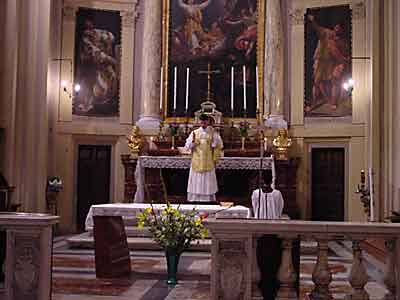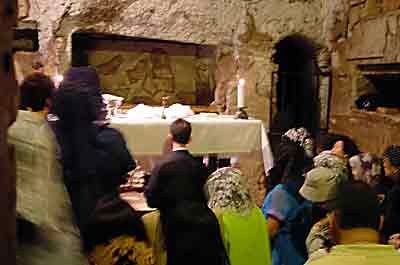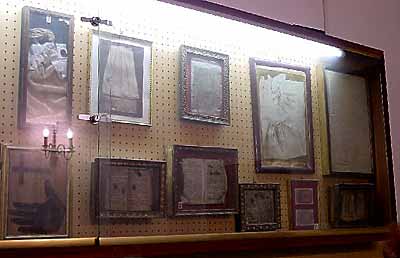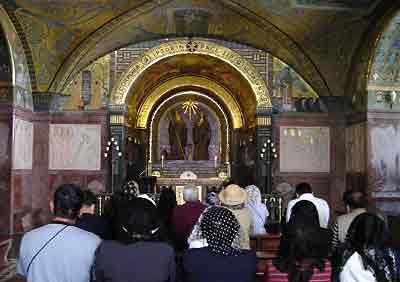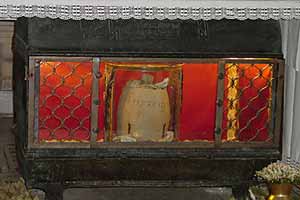

![]()
![]()
|
Newsletter of the District of Asia September-October 2000 SSPX
DISTRICT OF ASIA’S By
Bonnie Pleier and Maria Salas-Selem The meeting point for all the pilgrims of this two week long pilgrimage was Rome’s Fiumicino Airport. The first ones to arrive, actually a day earlier, were a few Japanese, then some Americans. The bulk of the group who had left separately from Manila and Singapore and united in Bangkok, arrived on Saturday morning at 6.00 am after a 15 hour flight. Our two buses however would not leave until the only two more we could wait for arrived, also from the USA, a couple of hours later. Others from the Philippines would arrive at noon, others still, from Korea and Japan the following day. The start of our pilgrimage shows the complicated coordination that was required for our international group.
Holy Mass in the church of St Pudentiana at the beginning of the pilgrimage Our Pilgrimage then began, after a bus trip to Rome in the rain, with the Holy Sacrifice of the Mass at the church of St Pudentiana, the first ever Mass center in Rome, established by St Peter, in the house of Senator Pudens. We learned later the story of this extraordinary family who benefited from a relatively young St Peter, just arrived in Rome in the 40s A.D. The grand-parents were Senator Pudens, one of the leading nobles of Rome and a member of the Senate, and his wife, St Priscilla. Their son was St Pudens. He married and had four children from Claudia Rufina, and all four became Saints: St Pudentiana, St Praxedes, St Timotheus and St Novatus. They were all baptized by St Peter. (From Pilgrims Walk in Rome, by P.J. Chandlery S.J., 1903) We were on a pilgrimage for the Jubilee, so throughout our trip, there were regular confessions, made easy by the presence of, usually, four priests, Fathers Couture, Griego, Onoda and Wailliez. The confessions, on this first day, were followed by lunch at a Chinese Restaurant and a visit to St. Mary Major. The highlights at St. Mary Major are some wood from the cradle of Our Lord, beautifully displayed in a golden crib underneath the Main Altar, the incorrupt body of St. Pius V, who immortalized the Tridentine Mass for all time, the painting of the Blessed Mother and Child possibly painted by St. Luke. At the tomb of St. Pius V, Fr. Couture led the group in the recitation of the rosary, in Latin, and, to our surprise, a lot of the people in the chapel, not of our group, joined in very devoutly. In the bus, Father Couture pointed out various sites remarking that there are two Romes: Christian Rome vs. Pagan Rome (the pornographic type billboards were very obvious throughout Rome). Father quoted a Saint who said that “as Rome goes, so goes the world”. (If the morality can be destroyed in the center of Catholicism which gives the norm of morality, Satan will have an easy job of taking over the world.) Day 2: Sunday, August 6, Feast of the TransfigurationWe visited the catacombs of St. Callixtus, these very impressive underground passages where pagans as well as Christians were buried. Father Griego was ready to celebrate the Holy Sacrifice of the Mass at one of the small altars, after the guided tour when he noticed that he had been provided with a ceramic chalice. Needless to say, he could not consecrate the Precious Blood in this type of chalice. So, instead, we prayed a rosary, led by Father Couture. He then gave a little sermon in which he stated, “The martyrs are the roots, the pioneers of our Holy Faith, which was watered by the blood of these saints. The fruits were the conversions of many pagans and complete overthrow of the Pagan Roman Empire.” This sermon gives us a lot to think about as we ask ourselves, “Will I be willing to give up my life for my faith when it is asked of me?”
The
Holy Rosary in the catacombs of St Callixtus
Fr Onoda managed to say mass for the group in a small chapel at a little distance of the entrance of the Catacombs where a proper chalice was available, while Fathers Couture and Griego had Mass at the Quo Vadis. This small church of Quo Vadis is where Our Lord met St. Peter as he was leaving Rome, utterly discouraged, and asked him: “Where are you going – Quo vadis?” An imprint of Our Lord’s foot is venerated in this church. We then went by bus into Rome, near St Peter’s actually, where we divided ourselves in small groups for lunch. Our next stop was the Church of the Gesu. This incredibly beautiful church contains real treasures: the miraculous picture of Our Lady of the Way, the body of St. Ignatius of Loyola and St. Francis Xavier’s hand, as well as the body of St Joseph Pignatelli. The main altar shows a painting of the presentation of Our Lord in the Temple with angels overlooking the scene while holding the instruments of Our Lord’s passion. What food for meditation! We then visited the church of the Sacred Heart, near Termini, run by the Salesian Fathers, before heading back to the hotel for dinner. Day 3: Monday, August 7 St Cajetan, ConfessorThis day and the following Friday, we had to divide the groups as part of our pilgrimage included the visit of the excavations beneath St Peter’s, and due to the size of our group, we had been given two different days for the visit.
Rome: Church of the Sacre Cuore One group therefore went to St Peter’s to find out that their morning guided tour had been postponed to the afternoon because of a celebration in honor of Pope Paul VI whose death anniversary had occurred the day before. So they decided meanwhile to visit a small church dedicated to the Sacred Heart, near Castel Sant’ Angelo, to find a place to offer two Masses (Fathers Couture and Wailliez were with this group) and to try to see the little known ‘Museum of Purgatory”. Both goals were happily reached.
Rome: Museum of the Holy Souls in Purgatory A nice Italian lunch followed. In the afternoon, the visit of the excavation was a tremendous experience, anchoring everyone’s heart on that Roman Rock which is Peter the Apostle, whose bones lie right beneath the Main Altar.
Monte Cassino: tombs of St Benedict and St Scholastica The other group, our group, left the hotel at 7:15 am for Monte Cassino, two hours South of Rome where Father Griego was privileged to offer the Holy Sacrifice of the Mass near the tombs of Saint Benedict and Saint Scholastica. During the Mass an elderly Benedictine monk came into the chapel and quietly knelt at the communion rail and stayed until after the consecration, then left. He came back and received Holy Communion from Father Griego and after a few moments left as quietly as he had arrived. We took a guided tour of the monastery and were honored to be in St. Benedict’s cell and to see the imprint of his elbow, which was left in a rock that he fell upon. We enjoyed the many beautiful paintings and the exquisite works of art in the main church. We found the men in uniform very unfriendly and uncooperative. It seemed like they were just putting up with the tourists. We were told there are only about 20 monks there now where there used to be hundreds by the size of it. We had lunch on the way to Naples. Visitors to Italy learn at their own expense the existence of the notorious afternoon siesta from 1:00 pm to 4:30 pm. Since we arrived around 1:30 pm, we couldn’t visit the churches we intended to, so we were given a tour of the city and at 4:30 were able to go into the church dedicated to the Assumption of Our Lady. It is in this beautiful cathedral where the miracle of the blood of St. Januarius takes place each year on September 19; his blood, in a phial, liquefies on his feast day.
Naples: The Reliquary with the Blood of St Januarius Because of the ‘sacred siesta time’ the group was disappointed in not being able to visit other places like St. Philomena’s sanctuary, in nearby Mugnano, the Shrine of Our Lady of the Rosary of Pompeii (the famous image with Our Lady giving the rosary to St Dominic and St Catherine of Sienna) and others. On the way back Father Griego gave us a wonderful short lecture reminding us that we were on a pilgrimage and that we should make use of all opportunities to make sacrifices. We were like thirsty sponges that just wanted more and more. After dinner at the hotel, we were able to help to put the Asian banners together. These were made of satin in different colors by a group of young ladies aspiring to the religious life from the Philippines, the famous ‘Bethanians’. Each had a picture in silk screen of the patron saint of the country or religious organization they represented and was decorated with golden tassels. It was all very rich and elegant |
